Defining your structure is charting the path that the audience will take through your presentation. A poor structure is disorienting and leaves the audience wondering how they will get to their destination (or what the destination even is). Invest time in defining your central message and present your results as the evidence to support it. Don’t forget to tailor how much context you provide in your introduction and conclusion to the audience you are presenting to.
| Contents |
| 1. Before your start 1.1. Identify your purpose 1.2. Analyze your audience 1.3. Craft a central message 2. Developing the content 2.1. Interpret the results 2.2. Explain your methods 2.3. Motivate your work 2.4. Describe your impact 3. Putting it together 4. Quick tips |
1. Before you start
Put away PowerPoint, Google Slides, and any software you’re tempted to open up. The first step to an effective presentation is clarifying your objectives, your audience, and your central (takeaway) message.
1.1. Identify your purpose
What do you want your audience to do, think, or feel after hearing your talk? Goals such as “update my audience” are short-sighted, but can be developed further. For instance, it could become “update my audience so they can appreciate all the promising work I’ve done and they’ll want to renew our grant.” Helpful goals are audience-centric and can inform what to include in your presentation.

1.2 Understand your audience
Think about who will be in attendance and tailor your talk to them. Determine your audience’s
- reason for attending your talk
- prior knowledge about your field or your work
- interests and motivations.
Understanding your audience will help you gauge how much background and technical detail to include. It will also help you motivate your work.
1.3 Craft a central message
Effective talks leave the audience with a clear take-away message. Based on your goal for the talk and the interests of your audience, create a single-sentence message that you would deliver to your audience. If an audience member thinks back about your talk and remembers a single thing, what should that be?

Also, make sure you understand the format and constraints of your talk, including how much time you will have, how your slides will be shown (large projector vs. small TV screen), and how many people will attend and how they will participate (questions during vs. after).
2. Developing your content
Your technical presentation should follow an hourglass-shaped narrative: start broadly with an issue that your audience cares about, lead into the specifics of your work, then open up again with what your results mean and how they link back to the bigger picture. When you structure your talk, however, start at the narrowest part of the hourglass—your results. Your central message will emerge from here.
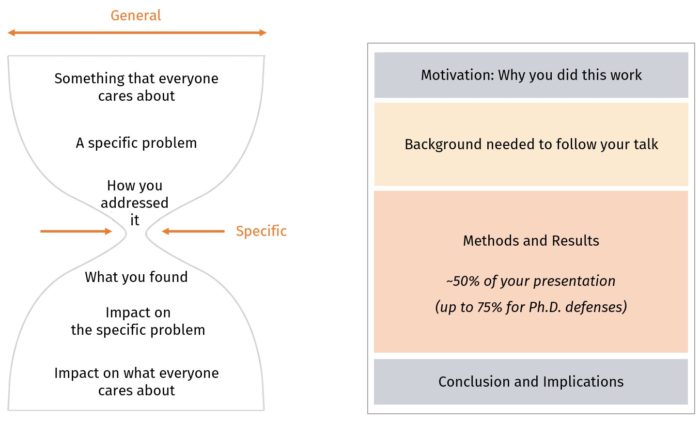
2.1. Interpret your results
The most important part of your talk to the majority of your audience is not your results themselves, but the message they support. Start planning your talk by looking at your results and deciding what main points you can draw from them.
Carefully group your results, not by how you performed the experiments, but by the main points they support. Aim for 2-4 groupings that each lead to a single main point. These 2-4 main points should form the evidence for the main message of your talk.
Filter out less relevant results based on how well they support your main points. You often just can’t fit everything into one talk, so be selective about what you include to maximize your impact.
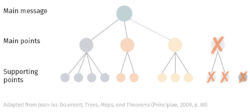
Evaluate your argument based on how well your results support your conclusions, and how well your conclusions support your main message. Look for logical holes in your argument, and address them or modify your main message to better fit your conclusions.
2.2 Explain your methods
Describe what you did to get to your results. Give your audience the information they need to understand your results (how you set up your experiment, simulation, etc.). Be selective about what information you include to keep focus on your central message.

2.3 Motivate your work
Explicitly tell your audience why they should invest time listening to your talk
Start with something your whole audience cares about. For expert audiences, this could be a specific problem, where for uninformed audiences it should be a more general goal for your field.
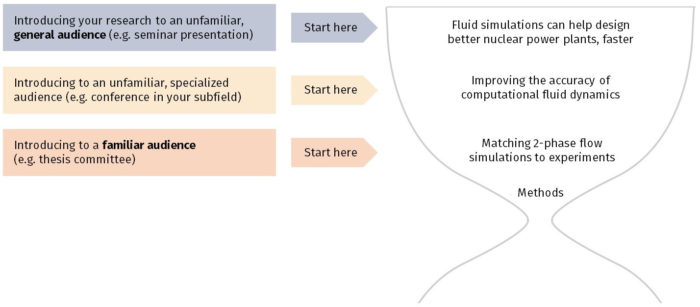
End with your most specific goal. Describe your project’s aim in one phrase, and then turn it into a “need” statement. Then, link your goal to the thing the audience cares about. Build out from both ends until you can logically link your specific goal to the general concern.

2.4 Describe the impact
How did your work address the needs from your motivation? Look forward to the future and describe the difference made by your work.
Start with the most direct impact of your work. What is at least one thing that your work directly accomplishes? What next steps does your work motivate?
Connect back to your motivation. Describe how you see your project evolving to have a larger impact. Explain how your (and your group’s/colleague’s/field’s) work is coming together to meet a larger goal. End by connecting back to the thing the whole audience cares about, not a “Questions?” “Thank you!” or “backups” slide.
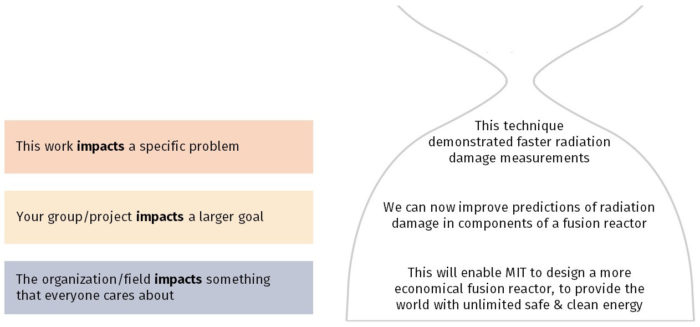
3. Putting it together
Build a slide list based on the information you gathered. Take your motivation, methods, results, and impact, and turn them into a series of sentences, each representing a single slide. These sentences will become your slide titles, and together they should form a coherent story.
Fill out your outline from your slide list. Plan out what evidence you’ll need to support each slide title.
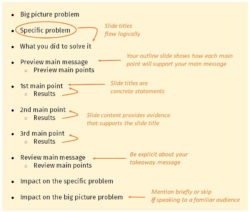
Now you can start creating slides!
4. Quick tips
- You can write, sketch, or storyboard your narrative to discover and develop your story. Just make sure that there is a clear logical flow leading from one point to the next.
- Do not focus on how many slides you should have. Especially in technical presentations, some of the content will be complex enough that animations will be needed, which will throw off your slide count. Instead, focus on constraints such as time limits and your audience’s capacity to understand your message.
- If you are recycling slides from a previous talk, take a moment to still go through the “Before you start” section. This will help ensure that you have a solid foundation for your new talk.
Additional resources
- Jean-luc Doumont, Trees, Maps, and Theorems (Principiae, 2009), specifically the “Designing the Presentation” chapter. You can borrow a copy from the NSE Communication Lab.
- Jean-luc Doumont’s one-page guide
To get started or receive feedback on your draft, make an appointment with us. We’d love to help!
